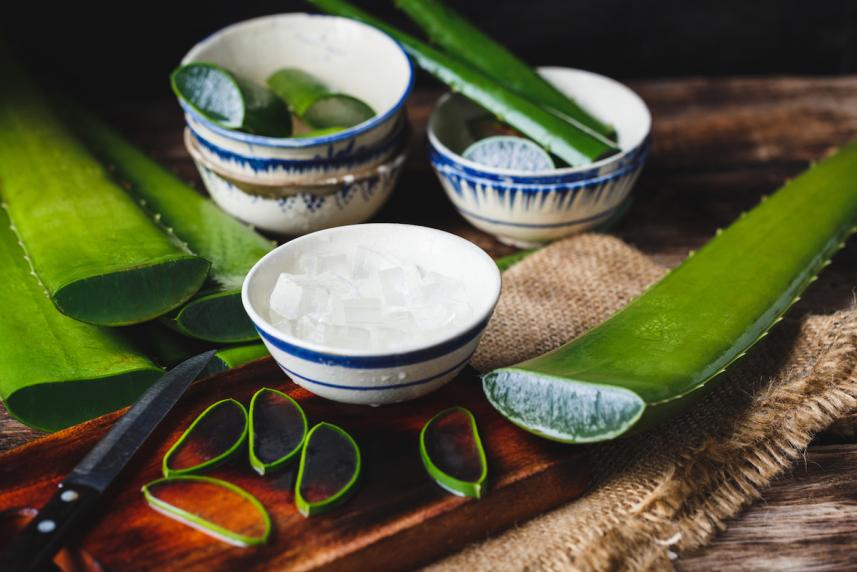Natural Remedies for 3 Summer Skin Ailments
Heal poison ivy, sunburn, and bug bites.

From the beach to the sun to the fresh fruit, the third season of the year is one packed with good vibes and refreshing waters. But along with the good comes a few unfortunate summer skin mishaps. We're talking poison ivy, sunburn, and bug bites and stings. Keep your summer healthy by following these preventive steps and natural treatments from Alan Dattner, MD, a holistic dermatologist in New York.
Poison Ivy: Poison ivy (or poison oak and sumac) blooms in the warmer months after a wet spring. Exposure to the oils of the plants can result in rashes and pustules. The best way to avoid poison ivy is to know what the plant looks like. Look for plants with clusters of three leaves that have a slightly reddish tint and may be shiny.
Treat It: Depending on how allergic you are, your reaction to exposure will vary. The best way to stop and limit a reaction is to wash as soon as possible after exposure, Dr. Dattner says. Use any kind of soap and take a full shower, using cool water, and launder any clothes you were wearing. Make sure to wash your dog or other pets you may have touched or who may have been exposed. Showering and washing immediately after exposure should stop a reaction for people with a normal tolerance, although if you experience extreme symptoms, or they sustain formore than a week, go see a doctor.
Sunburn: Perhaps the most widespread of summer ailments, sunburn is easy to prevent. Because frequent sunburn can lead to bigger problems like skin cancer, it's best to take preventive measures. While sunscreens and sunblock offer protection, Dr. Dattner recommends wearing protective clothing and staying in the shade. "The best sun protection is protective clothing. Sunscreen is preventative protection only where you can’t cover yourself up. Using proper clothing and [shade] should be the first option," he says. Any kind of long-sleeve clothes that are not sheer will work. White clothes have sun reflective qualities. Because sunscreens and sunblock contain chemicals that may act as endocrine disrupters and have other characteristics with unknown effects, Dr. Dattner recommends avoiding them when possible.
Treat It: Sometimes, even the most prepared get a little…burnt. The natural remedy is aloe, and if you have access to an aloe plant, simply snap off a leaf and break it open. Spread the salve from the inside of the plant on your burns to soothe them. Leave it on as long as you can. Rinse or wipe off with a damp cloth later. If you don't have access to a plant, look for 100% aloe salve at your drugstore.
Bug Bites: There are two categories of bug annoyances to deal with when summer rolls around: stings and bites. If you're very allergic, follow your doctor's instructions on how to stay safe during buggy weather. But for people with an average reaction to stings and bites, try to avoid them by staying inside after dusk when bugs appear, and wear long clothing when possible, Dr. Dattner says.
Treat It: For mosquito bites and bee stings, try an herbal antimicrobial. Plantago, or plantain, is a leaf that commonly grows in most lawns. If you smash it up and put it over a bite, it should relieve some itching and act as an antimicrobial to keep infection at bay, Dr. Dattner says. But to really relieve itching, a little bit of mud or clay over the bite will soothe and draw venom out to some extent, he says.
Tick bites should be treated with more caution. Ticks can be as small as a freckle or as large as a beetle, and they bite and bury into the skin to live off your blood. While some are harmless, ticks have been known to carry Lyme disease. After you go on a hike, go camping, or return from an area where ticks are known to be, thoroughly inspect your body. Ticks like to nest in warm, dark places like the armpits, scalp, groin, and areas where clothes are tight and fitted, like waistbands.
If you find a tick on your body that has bitten and embedded into your skin, head to a doctor who is equipped to remove and test the tick for disease, Dr. Dattner says. If you can’t get to the doctor, try to gently pry the tick out by using tweezers and do everything possible to keep the bug intact. Thoroughly clean the bite area and your hands with soap and water or rubbing alcohol. Put the tick in a container (without any liquid or alcohol), and bring it to a local health authority to get tested.
Watch out for these hazards and you’ll have even more fun this summer.



